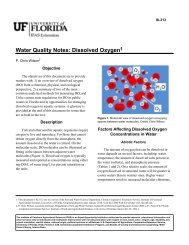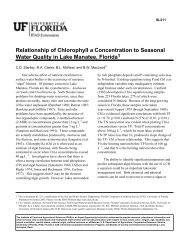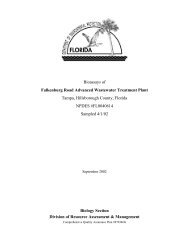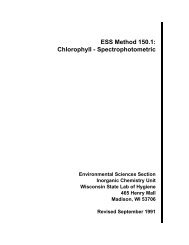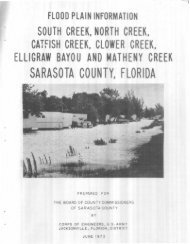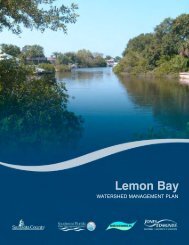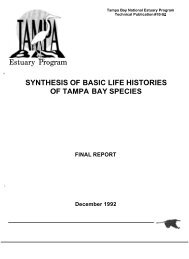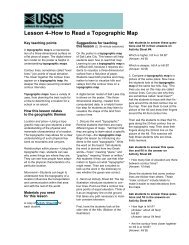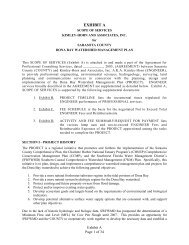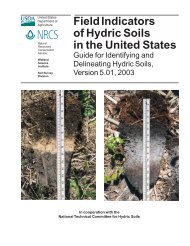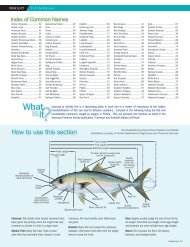NEAR-SURFACE DINAnnual median near-surface DIN concentrations ranged between 0.02 <strong>and</strong> 0.52 mg N/Lat the tidal <strong>Myakka</strong> <strong>River</strong> stations, <strong>and</strong> between 0.03 <strong>and</strong> 0.40 mg N/L at the tidal <strong>Peace</strong><strong>River</strong> stations (Appendix B). Median concentrations appear to vary inversely withsalinity in both river systems.If 0.01 mg DIN/L — which was the effective detection limit for DIN forms in the Districtmonitoring program for DIN forms, <strong>and</strong> the mid-range of potential N limitation valuesdiscussed by Chapra 1997 — is used to estimate the threshold for N limitation inphytoplankton, it appears that N availability may have limited phytoplankton productivityat several of the tidal river stations sampled during 1993-2000. DIN concentrationsbelow the laboratory detection limit were observed during at least one sampling event ateach station. The 25 th percentile value was equal to the detection limit in one or morewater years at each station, indicating that DIN concentrations equal to or less than thedetection limit were observed on 25% of the sampling dates at the station during thatyear.4.3 CHLOROPHYLL-aChlorophyll-a concentrations, which provide estimates of phytoplankton biomass in thewater column, are helpful indicators of a waterbody’s trophic state. A summary of nearsurfacechlorophyll-a concentrations observed at the tidal <strong>Peace</strong> <strong>and</strong> <strong>Myakka</strong> <strong>River</strong>monitoring stations is shown in Appendix B. Annual median values ranged between thelaboratory detection limit (1.0 µg/L) <strong>and</strong> 13 µg/L at the tidal <strong>Myakka</strong> stations <strong>and</strong>between 2.3 <strong>and</strong> 10.6 µg/L in the tidal <strong>Peace</strong>. The statewide median chlorophyll-aconcentration for Florida estuaries, as reported by Freidemann <strong>and</strong> H<strong>and</strong> (1989), is 8.5µg/L.Algal blooms (indicated by chlorophyll-a concentrations > 20 µg/L) occurred at everystation at some time during the monitoring period. Pronounced blooms, with chlorophyllconcentrations > 50 µg/L, were observed at three sites (CH-002, CH-02B, <strong>and</strong> CH-004).Annual mean chlorophyll-a concentrations observed at several stations during wateryears 1994-2000 exceeded 11 µg/L, a value that has been proposed by the State ofFlorida as representative of potentially impaired water quality conditions in the State’sestuarine waters. Stations <strong>and</strong> years where the proposed impairment level wereexceeded include:• CH-002 (water years 1995, 1999)• CH-02B (1995, 1998, 1999)• CH-029 (1995, 1996)• CH-004 (1994, 1995, 1996, 1999)• CH-05B (1999)• CH-005 (1994).56
5.0 REFERENCESCanfield, D., <strong>and</strong> M. Hoyer. 1988. Regional geology <strong>and</strong> the chemical <strong>and</strong> trophic statecharacteristics of Florida lakes. Lake <strong>and</strong> Reservoir Management 4:21-31.Charlotte Harbor Environmental Center (CHEC). 1999. Annual report on water qualitystatus <strong>and</strong> trends in the <strong>Peace</strong> <strong>and</strong> <strong>Myakka</strong> <strong>River</strong> basins. Charlotte Harbor NationalEstuary Program. North Ft. Myers, FLCharlotte Harbor Environmental Center (CHEC). 2000. Annual report on water qualitystatus <strong>and</strong> trends in the <strong>Peace</strong> <strong>and</strong> <strong>Myakka</strong> <strong>River</strong> basins. Charlotte Harbor NationalEstuary Program. North Ft. Myers, FLCharlotte Harbor Environmental Center (CHEC). 2001. Annual report on water qualitystatus <strong>and</strong> trends in the <strong>Peace</strong> <strong>and</strong> <strong>Myakka</strong> <strong>River</strong> basins. Charlotte Harbor NationalEstuary Program. North Ft. Myers, FLCoastal Environmental, Inc. 1995. Estimates of total nitrogen, total phosphorus, <strong>and</strong>total suspended solids loadings to Charlotte Harbor, Florida. <strong>Southwest</strong> Florida <strong>Water</strong>Management District. Tampa, FLCoastal Environmental/PBS&J, Inc. 1998. Tree mortality assessment of the upper<strong>Myakka</strong> <strong>River</strong> watershed. <strong>Southwest</strong> Florida <strong>Water</strong> Management District. Tampa, FLCochran, W.G. 1977. Sampling Techniques (3 rd Ed). Wiley. New York, NYFraser, T.H. 1991. The lower <strong>Peace</strong> <strong>River</strong> <strong>and</strong> Horse Creek: flow <strong>and</strong> water qualitycharacteristics, 1976-1986. pp 143-185 in R. Livingston (ed.) The <strong>River</strong>s of Florida.Springer-Verlag. NY, NYHammett, K. M. 1987. L<strong>and</strong> use, water use, streamflow, <strong>and</strong> water-qualitycharacteristics of the Charlotte Harbor inflow area, Florida. U.S. Geological SurveyOpen-File Report 87-472. Tallahassee, FLH<strong>and</strong>, J., J. Col, <strong>and</strong> E. Grimison. 1994. <strong>Southwest</strong> Florida district water quality: 1994305(b) technical appendix. Florida Department of Environmental Protection,Tallahassee, FLH<strong>and</strong>, J., J. Col, <strong>and</strong> L. Lord. 1996. <strong>Southwest</strong> Florida district water quality: 1996305(b) technical appendix. FDEP, Bureau of Surface <strong>Water</strong> Management.Tallahassee, FLLowrey, S.S., K.J. Babbitt, J.L. Lincer, S.J. Schropp, F.D. Calder, H.L. Windom, R.B.Taylor, <strong>and</strong> T. Hull. 1990. <strong>Myakka</strong> <strong>River</strong> Basin project: A report on physical <strong>and</strong>chemical processes affecting the management of the <strong>Myakka</strong> <strong>River</strong> Basin. FDER,Office of Coastal Management. Tallahassee, FL57
- Page 1 and 2:
Peace and Myakka RiverWater Quality
- Page 3 and 4:
CONTENTSExecutive Summary .........
- Page 5 and 6:
REPORT ORGANIZATION AND SCOPEThe pr
- Page 7 and 8:
“Good” water quality conditions
- Page 9 and 10:
The primary manmade influences incl
- Page 11 and 12:
Yields of total suspended solids (T
- Page 13 and 14:
are transported from fresh to more
- Page 15 and 16:
LIST OF FIGURESFigure 1. Map showin
- Page 17 and 18:
1.0 INTRODUCTION1.1 BACKGROUNDDurin
- Page 19 and 20:
maintaining water quality at levels
- Page 21 and 22: on the initial day of field work; t
- Page 23 and 24: Figure 1. Locations of USGS gaging
- Page 25 and 26: ANNUAL RAINFALLANNUAL STREAMFLOW% O
- Page 27 and 28: For this study, annual average WQI
- Page 29 and 30: • Big Slough Canal near Myakka Ci
- Page 31 and 32: Table 2. Annual WQI values for non-
- Page 33 and 34: Peace River at Zolfo Springs (USGS
- Page 35 and 36: Horse Creek near Myakka Head (USGS
- Page 37 and 38: Myakka River near Sarasota (USGS ga
- Page 39 and 40: 3.0 CONSTITUENT LOADS AND YIELDSEst
- Page 41 and 42: Table 3. Estimated annual TN loads
- Page 43 and 44: Table 5. Estimated annual NO 2+3 -N
- Page 45 and 46: Table 7. Estimated annual TP loads
- Page 47 and 48: Table 9. Estimated annual TSS loads
- Page 49 and 50: Myakka City gaging station (in wate
- Page 51 and 52: PEA CE CREEK CANAL nr WAHNETASADDLE
- Page 53 and 54: PEACE CREEK CANAL nr WAHNETASADDLE
- Page 55 and 56: PEACE CREEK CANAL nr WAHNETASADDLE
- Page 57 and 58: PEACE CREEK CANAL nr WAHNETASADDLE
- Page 59 and 60: PEACE CREEK CANAL nr WAHNETASADDLE
- Page 61 and 62: PEACE CREEK CANAL nr WAHNETASADDLE
- Page 63 and 64: PEACE CREEK CANAL nr WAHNETASADDLE
- Page 65 and 66: PEACE CREEK CANAL nr WAHNETASADDLE
- Page 67 and 68: ###TidalMyakkaRiverTidalPeaceRiverS
- Page 69 and 70: Median color values for Florida riv
- Page 71: ecorded at least once during most y
- Page 75 and 76: Water Quality Conditionsand Polluta
- Page 77 and 78: TURBIDITY (NTU), BY STATION AND WAT
- Page 79 and 80: TURBIDITY, BY STATION AND WATER YEA
- Page 81 and 82: TSS, BY STATION AND WATER YEARGAGE_
- Page 83 and 84: COLOR (PCU), BY STATION AND WATERGA
- Page 85 and 86: COLOR, BY STATION AND WATER YEARGAG
- Page 87 and 88: pH, BY STATION AND WATER YEARGAGE_N
- Page 89 and 90: SPEC. COND. (uS/CM), BY STATION AND
- Page 91 and 92: SPEC. COND., BY STATION AND WATER Y
- Page 93 and 94: DO, BY STATION AND WATER YEARGAGE_N
- Page 95 and 96: CHLA [MONOCHROMATIC, uG/L], BY STAT
- Page 97 and 98: CHLA [MONOCHROMATIC], BY STATION AN
- Page 99 and 100: NH4-N, BY STATION AND WATER YEARGAG
- Page 101 and 102: NO23-N (MG N/L), BY STATION AND WAT
- Page 103 and 104: NO23-N, BY STATION AND WATER YEARGA
- Page 105 and 106: TKN, BY STATION AND WATER YEARGAGE_
- Page 107 and 108: PO4-P (MG P/L), BY STATION AND WATE
- Page 109 and 110: PO4-P, BY STATION AND WATER YEARGAG
- Page 111 and 112: TP, BY STATION AND WATER YEARGAGE_N
- Page 113 and 114: TOC (MG/L), BY STATION AND YEARGAGE
- Page 115 and 116: TOC, BY STATION AND YEARGAGE_NUM WY
- Page 117 and 118: Near-surface salinity (ppt)SITE WY
- Page 119 and 120: Near-surface salinity (ppt)SITE WY
- Page 121 and 122: Near-surface color (PCU)SITE WY N M
- Page 123 and 124:
Near-surface TSS (mg/L)SITE WY N Mi
- Page 125 and 126:
Near-surface TSS (mg/L)SITE WY N Mi
- Page 127 and 128:
Near-surface turbidity (NTU)SITE WY
- Page 129 and 130:
Secchi depth (m)SITE WY N Minimum 2
- Page 131 and 132:
Secchi depth (m)SITE WY N Minimum 2
- Page 133 and 134:
Near-surface pHSITE WY N Minimum 25
- Page 135 and 136:
DO (mg/L) - all depthsSITE WY N Min
- Page 137 and 138:
DO (mg/L) - all depthsSITE WY N Min
- Page 139 and 140:
Near-surface PO 4 —P (mg P/L)SITE
- Page 141 and 142:
Near-surface DIN (mg N/L)SITE WY N
- Page 143 and 144:
Near-surface DIN (mg N/L)SITE WY N
- Page 145 and 146:
Near-surface chlorophyll-a (µg/L)S



